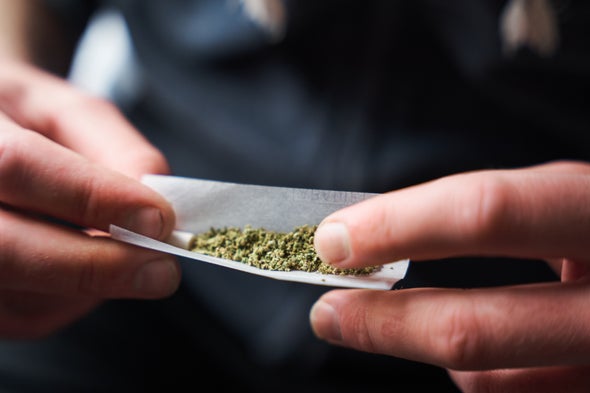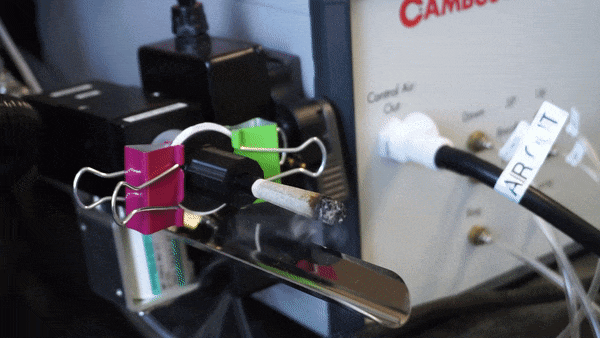Are you interested in learning how to roll the perfect joint? Well, we’ve got some interesting information for you. Recently, researchers conducted a study using a smoking machine to test the intensity of marijuana rolled into joints. It turns out that the amount of active ingredient that gets into the mouth actually depends on how the joint is engineered. Fascinating, right? In our upcoming article, we’ll dive deeper into this topic and discuss why standardizing marijuana products is so important for consumers’ knowledge of what they are buying.
Did you know that traditional smoking is actually the preferred method of consumption for about 70% of cannabis users? That’s a pretty significant number. Another interesting finding from the study is that the particle size in the joint can affect the intensity and duration of the high. So, if you’re looking to fine-tune your cannabis experience, understanding particle size is definitely important. And here’s something to keep in mind: the concentration of cannabinoids per puff is actually highest toward the end of the joint.
One interesting aspect of the study is the difference between CBD-dominant joints and THC-dominant joints. It turns out that CBD-dominant joints actually deliver a higher amount of cannabinoids to the mouth compared to THC-dominant joints. This is something that manufacturers and consumers alike should take into consideration. Additionally, the researchers found that joint construction can affect the delivery of terpenes, which can in turn affect the flavor and consistency of the product. All of these findings can be used by manufacturers to improve product quality and effects.
How to Roll the Perfect Joint
Rolling the perfect joint is an art form that requires precision and attention to detail. The way a joint is constructed can greatly impact the smoking experience, including the flavor, consistency, and intensity of the high. In this article, we will explore the importance of joint construction, the impact of particle size, the delivery of cannabinoids in joints, standardizing marijuana products, the traditional smoking method, testing joint intensity, improving product quality, addressing variability, and the implications for the marijuana industry.

Importance of Joint Construction
The role of joint construction in the smoking experience cannot be underestimated. Researchers have used a smoking machine to test the intensity of marijuana rolled into different joints. The results showed that the amount of active ingredient that gets into the mouth varies depending on how the joint is engineered. This means that the way a joint is rolled can directly affect the overall smoking experience.
Joint construction not only affects the intensity of the high, but it can also impact the flavor and consistency of the smoke. Different rolling techniques can enhance or diminish certain flavors, and the way the joint burns can affect how consistent the smoke is throughout.
Impact of Particle Size on Joint
Particle size plays a crucial role in the intensity and duration of the high. When marijuana is ground into smaller particles, it increases the surface area, allowing for more efficient extraction of the active ingredients. This results in a more potent high that may also last longer.
Understanding particle size is also important for product consistency and dosing control. When marijuana is ground too finely, it can lead to a harsher smoke and inconsistent burning. On the other hand, larger particles can result in a smoother smoke but may not deliver the desired potency.
Several factors influence particle size, including the grinding method, the strain of marijuana used, and personal preference. It is crucial to find the right balance in particle size to ensure a pleasant and consistent smoking experience.

Cannabinoid Delivery in Joints
Cannabinoids are the active compounds found in marijuana that produce the desired effects. Different cannabinoids have varying concentrations in joints, with THC and CBD being the most well-known. THC is known for its psychoactive effects, while CBD is non-psychoactive and may provide therapeutic benefits.
The concentration of cannabinoids per puff varies throughout the joint, with the highest concentration typically found toward the end. This means that the experience can change as the joint burns down.
CBD-dominant joints deliver a higher amount of cannabinoids to the mouth compared to THC-dominant joints. This can result in different effects, with CBD providing a more relaxing experience and THC offering a more euphoric high.
Understanding cannabinoid delivery in joints is essential for consumers to know what they are getting and how it will affect them. Standardizing marijuana products can provide consumers with the knowledge they need to make informed decisions.
Standardizing Marijuana Products
Standardizing marijuana products is crucial for consumer knowledge. With the increasing popularity and legalization of marijuana, consumers need to know what they are buying. Standardization ensures that the potency, flavor, and effects of marijuana products are consistent.
However, standardization is not without its challenges. The marijuana plant is complex, and variations can occur in different strains, growing conditions, and processing methods. Overcoming these challenges requires research and collaboration between industry professionals to establish guidelines and standards.

Traditional Smoking Method
Despite the emergence of alternative consumption methods such as vaping and edibles, traditional smoking remains the preferred method among cannabis users. According to studies, about 70% of cannabis users prefer smoking.
The advantages of the traditional smoking method are clear. Smoking allows for immediate effects, as the cannabinoids are quickly absorbed into the bloodstream through the lungs. The act of smoking can also be a ritualistic and social experience for many users.
Testing Joint Intensity
To ensure the quality and consistency of marijuana products, researchers use a smoking machine to test the intensity of joints. This machine simulates the smoking experience and measures the amount of active ingredient delivered to the mouth. Factors such as particle size, joint construction, and cannabinoid delivery can all influence the intensity of the joint.
Testing joint intensity provides valuable information for both manufacturers and consumers. Manufacturers can use this data to improve their products and ensure that each joint delivers the desired effects. Consumers can make more informed decisions based on the intensity of a joint, allowing them to choose products that suit their preferences and needs.
Improving Product Quality
Research findings on joint construction, particle size, and cannabinoid delivery can be applied to enhance product quality. Manufacturers can utilize this knowledge to develop consistent and high-quality marijuana products. By understanding how different factors affect the smoking experience, manufacturers can create products that deliver the desired effects and flavors consistently.
Improving product quality benefits both manufacturers and consumers. Manufacturers can establish a reputation for producing high-quality products, leading to increased customer satisfaction and loyalty. Consumers can enjoy a more enjoyable smoking experience and have confidence in the products they purchase.
Addressing Variability
Variability in joint architecture can have a significant impact on the smoking experience. It is essential to identify and address factors that affect joint construction, flavor, consistency, and effects. Further research is needed to gain a better understanding of these factors and develop strategies to minimize variability.
By addressing variability, manufacturers can ensure that each joint provides a consistent smoking experience, regardless of the brand or strain. This contributes to consumer satisfaction and builds trust within the industry.
Here is a Step by Step Guide on How to Roll the Perfect Joint

My perfect joint with a firecracker twisted end.
- Gather Your Materials: You’ll need rolling papers, a grinder, a filter or ‘crutch’ (optional but recommended), and, of course, your cannabis. Get everything ready so you’re not searching around halfway through.
- Grind Your Bud: Pop your broken up cannabis into the grinder and twist away. You want it all nicely ground up, but not too fine – think the consistency of oregano. This is to ensure an even burn. Also, to achieve a better even burn and for a smoother smoke, make sure to pick out unwanted material like stems and leaf if any.
- Make Your Filter (If Using One): If you’re using a filter or crutch, you’ll want to make that next. Some folks lime in BC fir example prefer to roll without, but a filter can help keep your joint sturdy and prevent bits of cannabis from falling out or going into your mouth. To make one, you can fold a small piece of thin cardboard or a business card a couple of times, then roll it into a cylinder that fits your paper.
- Lay Out Your Paper: Grab your favorite rolling papers and lay it out in front of you. It’s shaped like a rectangle, and you want the sticky side (the edge with the thin line of glue) facing you and on the top.
- Fill ‘er Up: Sprinkle your ground cannabis evenly along the paper. Try not to overdo it – you don’t want your joint to be so fat it won’t close. Leave a little space at the end without any cannabis for the filter.
- Position Your Filter: If you’re using a filter, pop it at the end where you left the space. It should be snug but not too tight. You can also do like me, and put ther filter in after you roll the joint,
- Roll It: This is the trickiest part. You want to use your thumbs and index fingers to shape the joint, compacting the cannabis and rolling the non-sticky side of the paper down and over the weed and back up to the sticky side. Try to keep the cannabis evenly distributed for a smooth smoke.
- Seal the Deal: Once your joint is shaped, lick the sticky edge of the paper and roll it down over the rest of the joint to seal it.
- Pack It: The end of the joint opposite the filter might be a bit loose, so use something like a pen to gently pack it down. You can add more weed if desired here to get more bang for your buck.
- Twist the Top: Lastly, twist the end of the joint to seal it up. Twist it so it looks like a small firecracker.
- Light Up and Enjoy: There you go. You’ve rolled yourself a joint. Now all that’s left is to light the end, take a gentle puff, and enjoy responsibly. Light it evenly so it burns evenly.
Conclusion
In conclusion, rolling the perfect joint is not only an art form but also a science. Joint construction, particle size, and cannabinoid delivery all play crucial roles in the smoking experience. By understanding the impact of these factors, manufacturers can improve product quality and enhance consumer satisfaction.
Standardizing marijuana products is important for consumer knowledge, but it comes with challenges due to the complexity and variability of the plant. Further research is needed to address factors that affect joint architecture and effects, ultimately leading to a better understanding and standardization of marijuana products.
Overall, the research and insights into joint construction and its impact on the smoking experience have significant implications for the marijuana industry. By utilizing this knowledge, manufacturers can create high-quality products that consistently deliver the desired effects, flavors, and potency.


